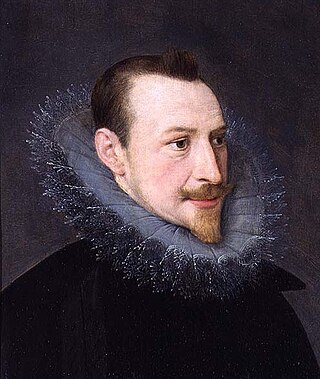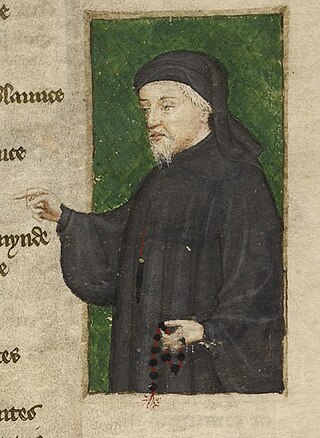
Edmund Spenser was an English poet best known for The Faerie Queene, an epic poem and fantastical allegory celebrating the Tudor dynasty and Elizabeth I. He is recognized as one of the premier craftsmen of nascent Modern English verse, and he is considered one of the great poets in the English language.

Geoffrey Chaucer was an English poet, author, and civil servant best known for The Canterbury Tales. He has been called the "father of English literature", or, alternatively, the "father of English poetry". He was the first writer to be buried in what has since come to be called Poets' Corner, in Westminster Abbey. Chaucer also gained fame as a philosopher and astronomer, composing the scientific A Treatise on the Astrolabe for his 10-year-old son, Lewis. He maintained a career in the civil service as a bureaucrat, courtier, diplomat, and member of parliament.
A heroic couplet is a traditional form for English poetry, commonly used in epic and narrative poetry, and consisting of a rhyming pair of lines in iambic pentameter. Use of the heroic couplet was pioneered by Geoffrey Chaucer in the Legend of Good Women and the Canterbury Tales, and generally considered to have been perfected by John Dryden and Alexander Pope in the Restoration Age and early 18th century respectively.
Poetry is a form of literary art that uses aesthetic and often rhythmic qualities of language to evoke meanings in addition to, or in place of, literal or surface-level meanings. Any particular instance of poetry is called a poem and is written by a poet. Poets use a variety of techniques called poetic devices, such as assonance, alliteration, euphony and cacophony, onomatopoeia, rhythm, and sound symbolism, to produce musical or other artistic effects. Most written poems are formatted in verse: a series or stack of lines on a page, which follow a rhythmic or other deliberate structure. For this reason, verse has also become a synonym for poetry.

This article focuses on poetry from the United Kingdom written in the English language. The article does not cover poetry from other countries where the English language is spoken, including the Republic of Ireland after December 1922.

John Gower was an English poet, a contemporary of William Langland and the Pearl Poet, and a personal friend of Geoffrey Chaucer. He is remembered primarily for three major works—the Mirour de l'Omme, Vox Clamantis, and Confessio Amantis—three long poems written in French, Latin, and English respectively, which are united by common moral and political themes.
Rhyme royal is a rhyming stanza form that was introduced to English poetry by Geoffrey Chaucer. The form enjoyed significant success in the fifteenth century and into the sixteenth century. It has had a more subdued but continuing influence on English verse in more recent centuries.

John Lydgate of Bury was an English monk and poet, born in Lidgate, near Haverhill, Suffolk, England.
Poetry took numerous forms in medieval Europe, for example, lyric and epic poetry. The troubadours, trouvères, and the minnesänger are known for composing their lyric poetry about courtly love usually accompanied by an instrument.

Medieval literature is a broad subject, encompassing essentially all written works available in Europe and beyond during the Middle Ages. The literature of this time was composed of religious writings as well as secular works. Just as in modern literature, it is a complex and rich field of study, from the utterly sacred to the exuberantly profane, touching all points in between. Works of literature are often grouped by place of origin, language, and genre.

"The Knight's Tale" is the first tale from Geoffrey Chaucer's The Canterbury Tales.
Terza rima is a rhyming verse form, in which the poem, or each poem-section, consists of tercets with an interlocking three-line rhyme scheme: The last word of the second line in one tercet provides the rhyme for the first and third lines in the tercet that follows. The poem or poem-section may have any number of lines, but it ends with either a single line or a couplet, which repeats the rhyme of the middle line of the previous tercet.

Narrative poetry is a form of poetry that tells a story, often using the voices of both a narrator and characters; the entire story is usually written in metered verse. Narrative poems do not need to rhyme. The poems that make up this genre may be short or long, and the story it relates to may be complex. It is normally dramatic, with various characters. Narrative poems include all epic poetry, and the various types of "lay", most ballads, and some idylls, as well as many poems not falling into a distinct type.

"The Squire's Tale" is a tale in Geoffrey Chaucer's The Canterbury Tales. It is unfinished, because it is interrupted by the next story-teller, the Franklin, who then continues with his own prologue and tale. The Squire is the Knight's son, a novice warrior and lover with more enthusiasm than experience. His tale is an epic romance, which, if completed, would probably have been longer than rest of the Tales combined. It contains many literary allusions and vivid descriptions.

The House of Fame is a Middle English poem by Geoffrey Chaucer, probably written between 1374 and 1385, making it one of his earlier works. It was most likely written after The Book of the Duchess, but its chronological relation to Chaucer's other early poems is uncertain.

Confessio Amantis is a 33,000-line Middle English poem by John Gower, which uses the confession made by an ageing lover to the chaplain of Venus as a frame story for a collection of shorter narrative poems. According to its prologue, it was composed at the request of Richard II. It stands with the works of Chaucer, Langland, and the Pearl poet as one of the great works of late 14th-century English literature. The Index of Middle English Verse shows that in the era before the printing press it was one of the most-often copied manuscripts along with Canterbury Tales and Piers Plowman.
Fables, Ancient and Modern is a collection of translations of classical and medieval poetry by John Dryden interspersed with some of his own works. Published in March 1700, it was his last and one of his greatest works. Dryden died two months later.
Chaucer's influence on 15th-century Scottish literature began towards the beginning of the century with King James I of Scotland. This first phase of Scottish "Chaucerianism" was followed by a second phase, comprising the works of Robert Henryson, William Dunbar, and Gavin Douglas. At this point, England has recognised Scotland as an independent state following the end of the Wars of Scottish Independence in 1357. Because of Scottish history and the English’s recent involvement in that history, all of these writers are familiar with the works of Geoffrey Chaucer.

John Shirley was an author, translator, and scribe. As a scribe of later Middle English literature, he is particularly known for transcribing works by John Lydgate and Geoffrey Chaucer.













